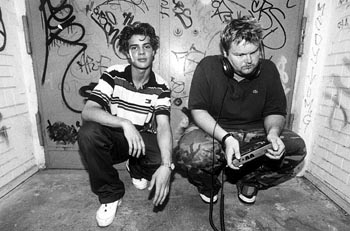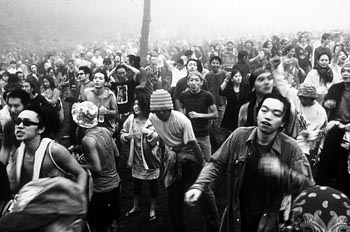Iara Lee's World Beat
Director Iara Lee goes back to the future
By Michelle Goldberg
Director Iara Lee hopscotches the world so much that she makes our planet seem as small as a city block. Raised in Brazil by Korean parents, she and her husband, San Jose Sharks owner George Gund, divide their time between Manhattan and San Francisco--that is, when they're not on location in Osaka, Moscow, Singapore, Helsinki, Paris or Budapest, just a few of the cities in which Lee filmed Modulations, her futuristic documentary about machine music.
Her international sensibility is a perfect fit with her subject: the electronic-music underground that's exploded into the first truly global youth culture. Modulations includes footage of a Prodigy concert in Moscow's Red Square, a rave on Japan's Mount Fuji, Berlin's Love Parade, and warehouse parties in Detroit, New Jersey and Chicago. What's striking is how similar it all is.
"It's pretty amazing," says Lee between bites of sushi at San Francisco's M. Point restaurant. (Gund is there, too, but he says very little.) "Rave music is huge even in Communist countries," Lee continues. "When I was in Singapore, they had this incredible club that looks like Ministry of Sound in London. We were visiting Czech cities, and they were listening to the same music and dancing to the same beats. So it's a pretty universal youth culture phenomenon."
Whether you think this disco Baraka is a sign of worldwide harmony or odious cultural hegemony, there's little question that Lee has captured a paradigm-busting erosion of boundaries--boundaries between cultures and genres, and between humans and machines. "Technology makes us feel everywhere and nowhere at the same time," Lee says. "To be physically in one place and mentally somewhere else--the whole concept of space and time are so twisted." Music writer Kodwo Eshun, a frequent talking head in Modulations, explains the international alchemy that led to house music: "You could hear previously disconnected worlds suddenly kind of imploding together--you could hear the world of Kraftwerk impacting with the world of the Bronx. That seemed very exciting, because at the time those worlds seemed very far apart."
In Modulations, though, Lee's subject is much narrower, and her research is as meticulous as her visuals are anarchic. She combines a detailed explanation of electronic music's evolution from Karlheinz Stockhausen and John Cage through disco, house, jungle and beyond with the carnivalesque images that distinguished Synthetic Pleasures: computer graphics, high-speed cityscapes and dancers partying all over the world.
"That was the whole purpose, to bring some credibility and validity to the culture, because the film is not about the latest trend. It didn't start in the '70s or '80s; it goes way back. Bringing musique concrète, Stockhausen and John Cage to the surface gives the project a longevity that it wouldn't have if I just started from Kraftwerk," Lee says. "When we first started the project, we were going to do just from Kraftwerk on, but once I started doing research--the more I discovered about it--I was like, wow. Even in 1913, Luigi Russolo wrote this manifesto, 'The Art of Noises,' and brought it to my attention that any sound, any noise, can be incorporated as music. Isn't that amazing? From that point on, it's been a slow revolution."
Russolo's manifesto said, "We must break out of this limited circle of sounds and conquer the infinite variety of noise-sounds." It's an argument that feels intuitively true to anyone who has ever stumbled down the street after an all-night party and found herself nodding her head to a construction crew's jackhammer or a car alarm. Modulations makes a similar case--that anything can be music. Thus Lee films ambient artist Tetsu Inoue sampling sounds from his fax machine, his microwave and his refrigerator.
"It's kind of interesting when the manufacturing places first created synthesizers, they were considered failures because they didn't sound like acoustic instruments," Lee explains. "They were trashed. And then these kids took the synthesizers, and they explored them for what they actually sound like--they sound like synthesizers, you know? And a whole genre of music started with these 'failure' machines. We can always twist things around and use technology to be creative, instead of just replacing the natural world or the acoustic instrument."
Lee says that she is "particularly interested in the bedroom musician, how kids kind of roll out of bed in the middle of the night and make a track. How does technology empower kids, how does technology make us more creative and how does technology connect us to people instead of isolating us from people? That's my main preoccupation with the investigation that I started with Synthetic Pleasures and continue with this new film."
Modulations explores philosophical questions about technology's alternately alienating and connective potential. It is also a lightly sociological study of the conditions that led to the birth of electronic music's multifarious microgenres. Juan Atkins explains the birth of Detroit techno as an imaginative defense against rust-belt despair.
"Detroit is such a desolate city that you almost have to dream of the future to escape your surroundings," Atkins says. A quote of his þashes across the screen: "There are no UFOs. Machine music is the only way forward." And though there's little talk about electronic music's drug culture, there is an attempt to link different genres to their chemical companions. "Music changed dramatically in the mid-'90s when people started experiencing the dark sides of Ecstasy. That's when rave turned into jungle," says Simon Reynolds, critic and author of Generation Ecstasy.
Beyond all the theorizing, though, Modulations is a who's who of techno music and turntable culture, featuring interviews with Carl Cox, Danny Tenaglia, DJ Spooky, Goldie, Moby, Prodigy and, from the Bay Area, Meat Beat Manifesto and the Invisbl Skratch Piklz. Sometimes, Lee had to interview three musicians in three countries on the same night. In what she calls "virtual filmmaking," she would hire a cameraman in a distant city, email him the questions, then get the tape rushed to her.
Some artists were more comfortable talking virtually, anyway, and their aversion to human contact adds a skeptical note to the film. Future Sound of London would only do its interview on a monitor through an ISDN line--the same way the group does its concerts. "The fact that I did this ISDN interview with them [gives it] a little bit of a critical tone," Lee says. "These guys cannot even show up on stage to do their live gigs. They have to do these things through the phone. From that point of view, one can judge that it's a little silly."
At one point in the film, Mixmaster Morris says, "There's a great struggle going on of what do we do without humanness. When do we give up our humanness and accept the machine?" The spectacle of thousands of screaming fans dancing before a giant monitor at a Future Sound of London show provides a counterpoint to all the utopian rhapsodizing about the democratic potential of rave culture.
"Again, it's a very interesting discussion that we started with the first film and keep coming back to," Lee says. "It's a huge concern--the machine and the human, and when do we let the machines take over? We always have to check ourselves. The whole concept of the Future Sound of London is interesting. I was a little amazed. We were at this huge festival, and the members of the band are just in their studio in London. The whole concert is on multiscreens with visuals, and you have thousands and thousands of people dancing in front of this multiple-monitor situation."
But the obsolescence of the performer has its upside. "At the Rainbow 2000 rave on Mount Fuji, the typhoon was going on, and the stage was always covered with plastic, so again kids were dancing all day and all night in front of this stage where they were not able to see the musicians. But that didn't stop them; they were dancing all night," Lee says.
"I had access to the musicians," Lee continues, "because I was backstage, and the musicians were totally into it, even though they couldn't see the audience. So it makes you think, well, this is a little twisted. You come for a live gig, and therefore maybe you want to see the musicians. But at the same time, it's not about the cult of the persona, it's about the sound. As long as the music is good, it's a party."
Because Modulations is all about computerized spectacle and sensory overload, there's something rather tame about seeing it in a conventional multiplex, so Lee has tried to take her movie beyond staid theaters.
"In Miami, during the winter music conference, we had a huge lineup of musicians, and before the live gigs we presented the film on multiple monitors throughout the club," Lee says. "George was very worried that people would not pay attention, but actually they came, they watched, and then the club person said, 'Why don't you run the visuals during the band?' We did, and people were hypnotized."
Lee and Gund held a huge outdoor screening in Montreal, and they hope to have more showings in nightclubs. "We're trying to find unusual venues," Lee says, "because it's true, to go to a big blockbuster movie theater to see a film like ours, it's just not, you know ..." Then she turns excitedly to her husband: "George, let's show our film at the Sharks arena! Let's throw a rave party at the Sharks arena!"
It's hard not to wince a little upon hearing Lee say that, because it raises many of the criticisms that people whisper about her--that her marriage to Gund has given her advantages she didn't earn, that she's riding his coattails. See, Lee is 32. Gund is 62, rich and hugely well-connected in the film world. He's chairman of the board at the San Francisco International Film Festival, he sits on the board of trustees of the Sundance Institute, and he's a member of the film committee of the Museum of Modern Art in New York.
But Lee is talented. She has a near-genius for nailing cultural phenomena, organizing oceans of information and incorporating delicious eye-candy images into the often dull medium of nonfiction film. Her movies would be fascinating no matter who her husband was.
Still, she's up front about the fact that he's helped her, saying, "We think life and work is kind of the same thing. He really likes to take chances. He's the kind of person who will support and promote something ahead of the game. He's obviously given me resources and psychological support and all the things an artist can't go very far without. It's been an intense and productive collaboration."
Besides, Gund's bucks couldn't buy Lee the lunatic energy she pours into her work. Besides making films, Lee and her husband's company, Caipirinha (the name of a sweet Brazilian cocktail), also run a record label and a clothing line, and Lee's working on a deal to write a Modulations book. She is in preproduction for her first feature film, to be based on the 19th-century Brazilian novel Dom Casmurro, and she's also making a short, impressionistic documentary about contemporary architecture.
The architecture project came about when Lee was promoting Modulations. She was getting bored traveling all over the world and wanted something to work on, so she started shooting footage of buildings in Tokyo, Barcelona and Copenhagen.
"Talk about being everywhere and nowhere!" she says. "I go to Tokyo and see Kinko's--everything is becoming so homogeneous, and sometimes it's a little disturbing. Cultures mix together and are becoming so international. You have a skyscraper that could be in New York or Europe or Africa. I'm intrigued with this whole homogeneous culture."
Combining her interest in buildings with her love of new sounds, Lee has commissioned a series of recordings made by musicians inspired by architects. The first one will be a collaboration between two electronic musicians--Taylor Deupree, who's American, and Savvas Ysatis, who's Greek--based on the work of Japanese architect Toyo Ito. For the second album, the musician is Japanese and the architect British, and the third will feature a German musician and a French architect.
It sounds like that classic rock-critic dis--"Writing about music is like dancing about architecture"--but in Lee's electric, kinetic little world, dancing about architecture makes perfect sense. "We like to juxtapose the opposites, you know? And mix it together. This is the culture of hybrid. It's not about one thing or the other, it's about mixing things together. Analog, digital, humans, machines--that's when you have very creative results."
[ San Francisco | MetroActive Central | Archives ]
Copyright © Metro Publishing Inc. Maintained by Boulevards New Media.
![]()

 Lee began her investigation into technological culture with her first film, Synthetic Pleasures. But Synthetic Pleasures, which included segments about virtual reality, smart drugs, plastic surgery, cryogenics, indoor beaches and a host of other human attempts to combat or surpass nature, was a bit too scattered. Without a clear focus, it ended up as more of a free-form essay than an exposition.
Lee began her investigation into technological culture with her first film, Synthetic Pleasures. But Synthetic Pleasures, which included segments about virtual reality, smart drugs, plastic surgery, cryogenics, indoor beaches and a host of other human attempts to combat or surpass nature, was a bit too scattered. Without a clear focus, it ended up as more of a free-form essay than an exposition.

Talking Shop: Musicians take a break from spinning to discuss their craft in Iara Lee's new film, 'Modulations.'
Transglobal Underground: Ecstatic ravers danced all day and all night at the Rainbow 2000 party on Mount Fuji, Japan, despite being unable to see the performers on stage.
From the August 10-23, 1998 issue of the Metropolitan.
![[MetroActive Movies]](http://metroactive.com/movies/gifs/movies468.gif)